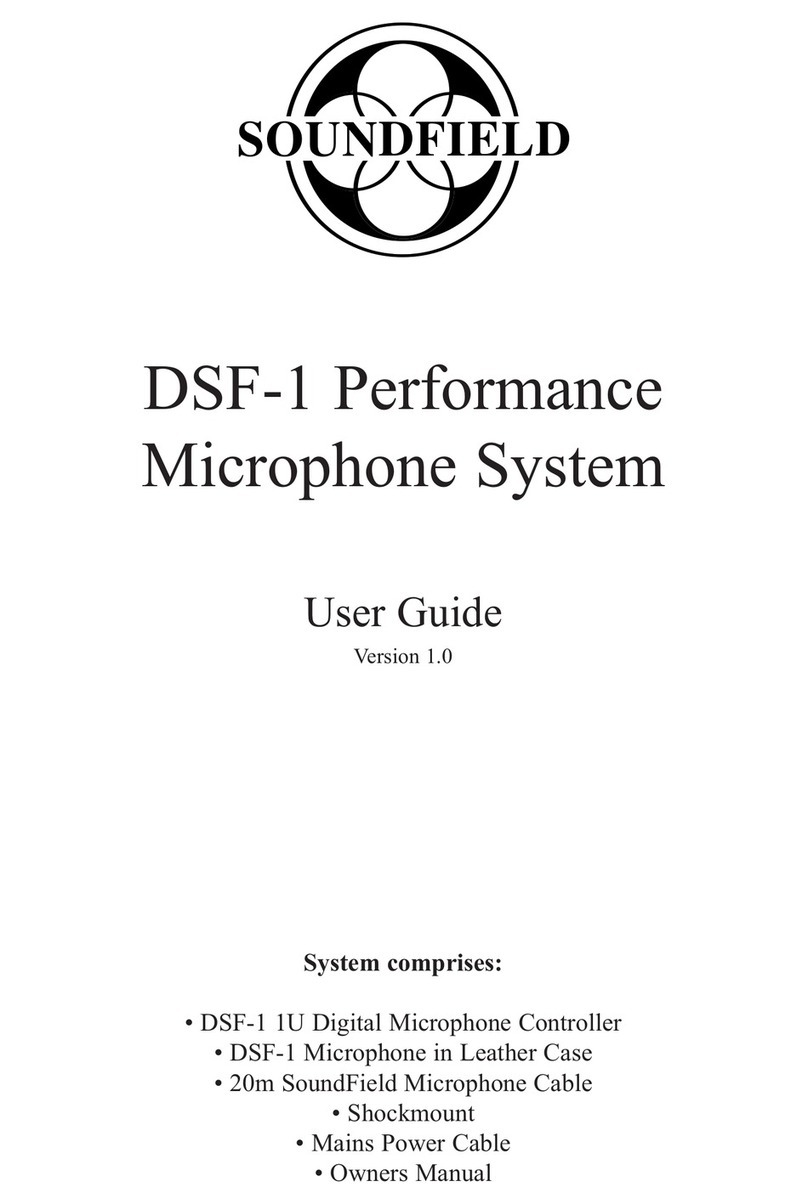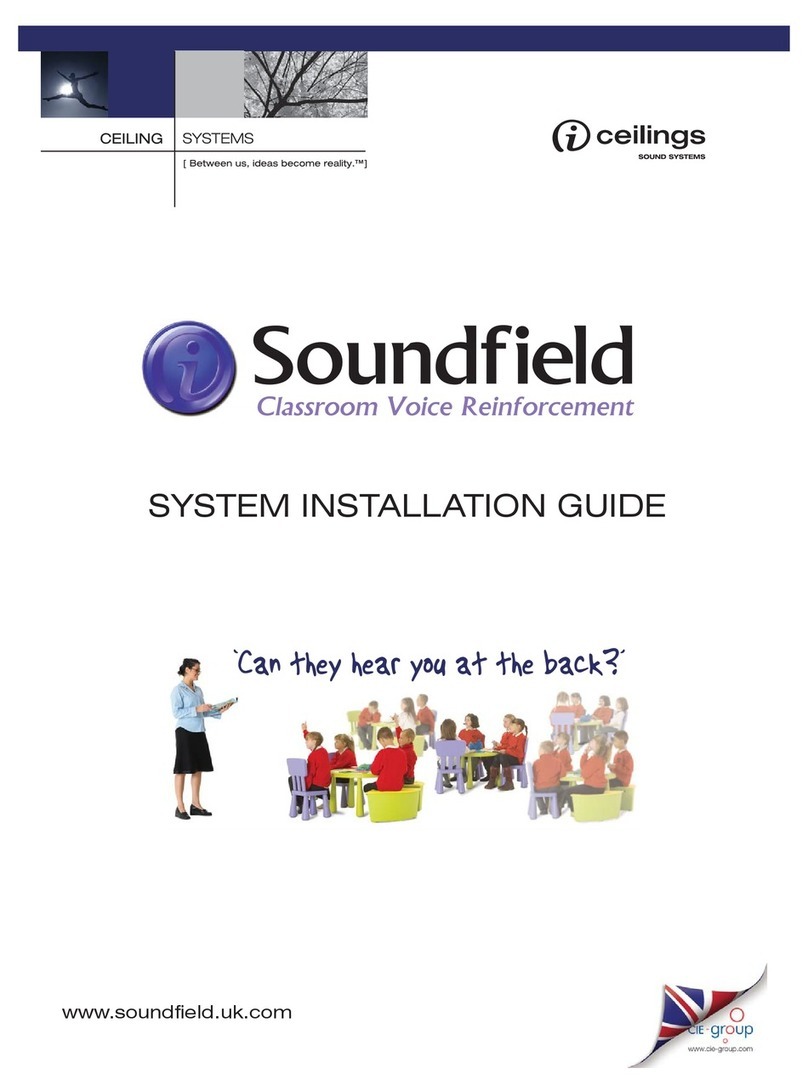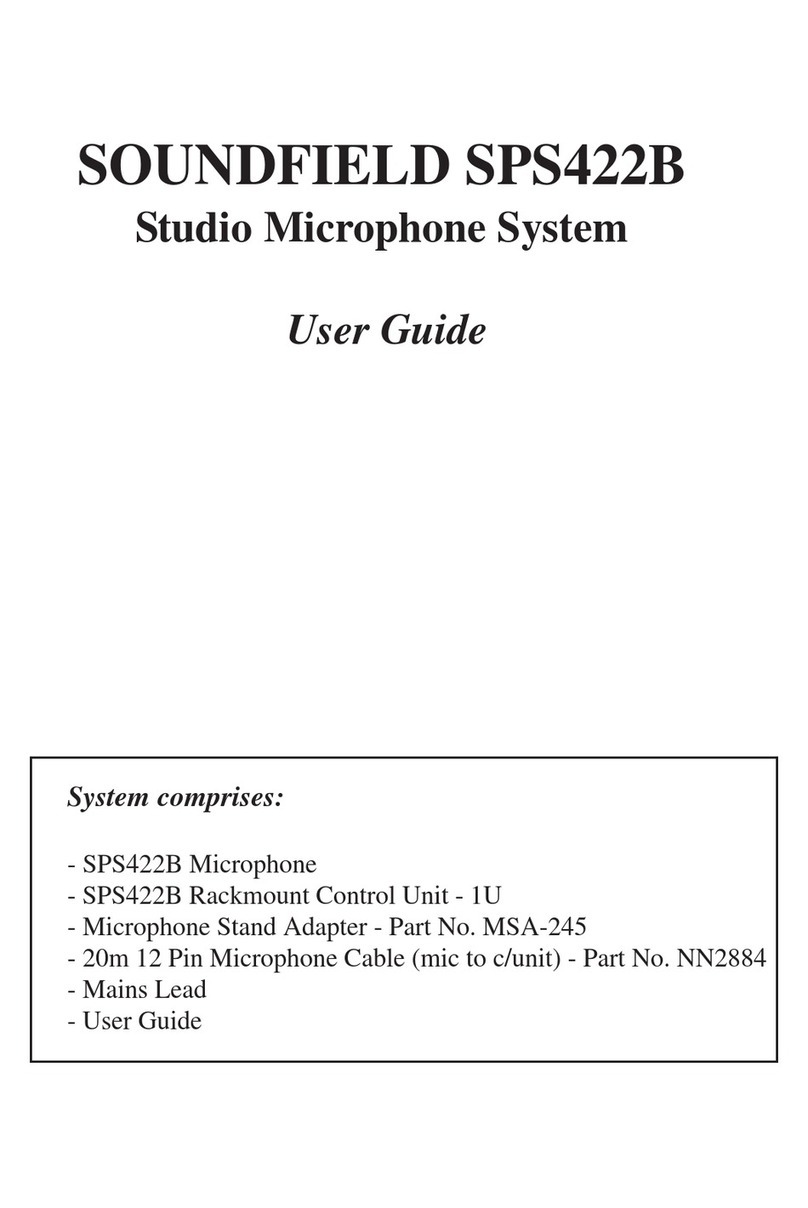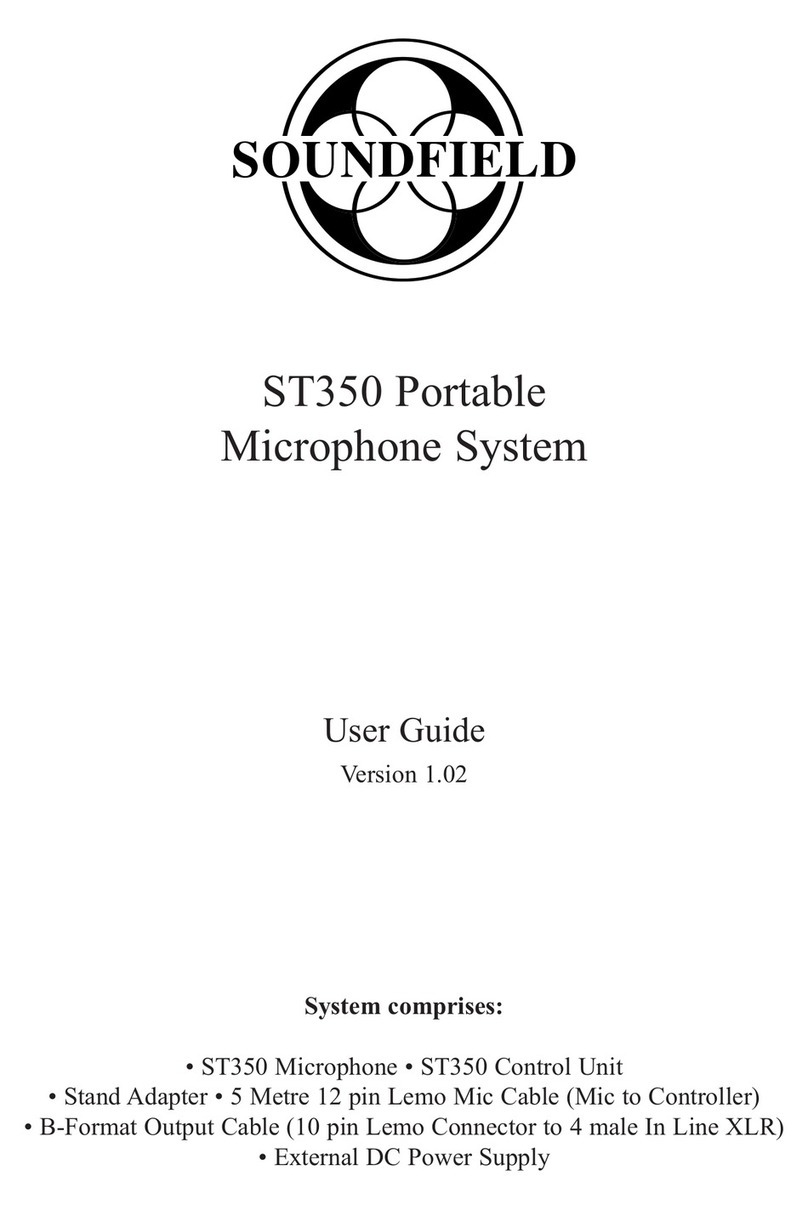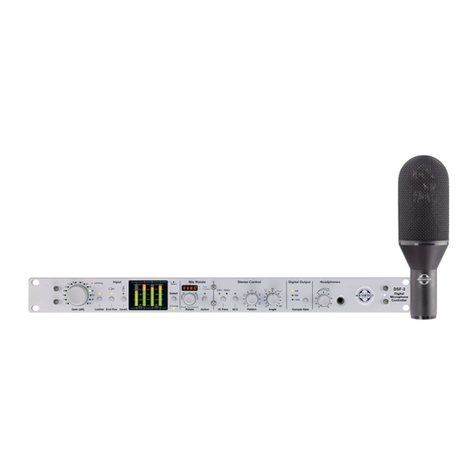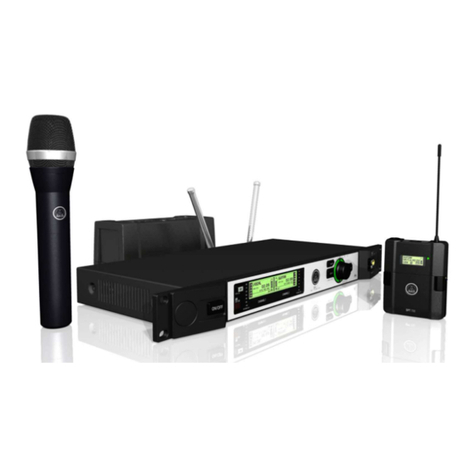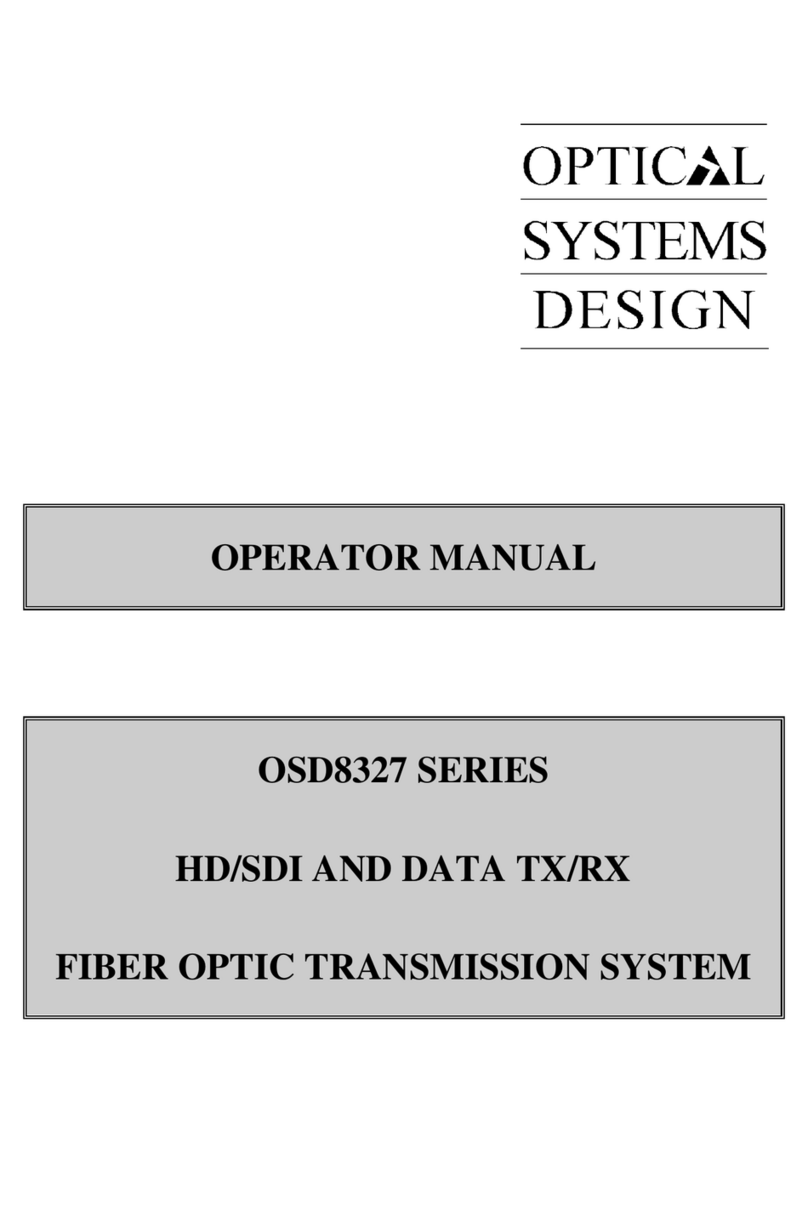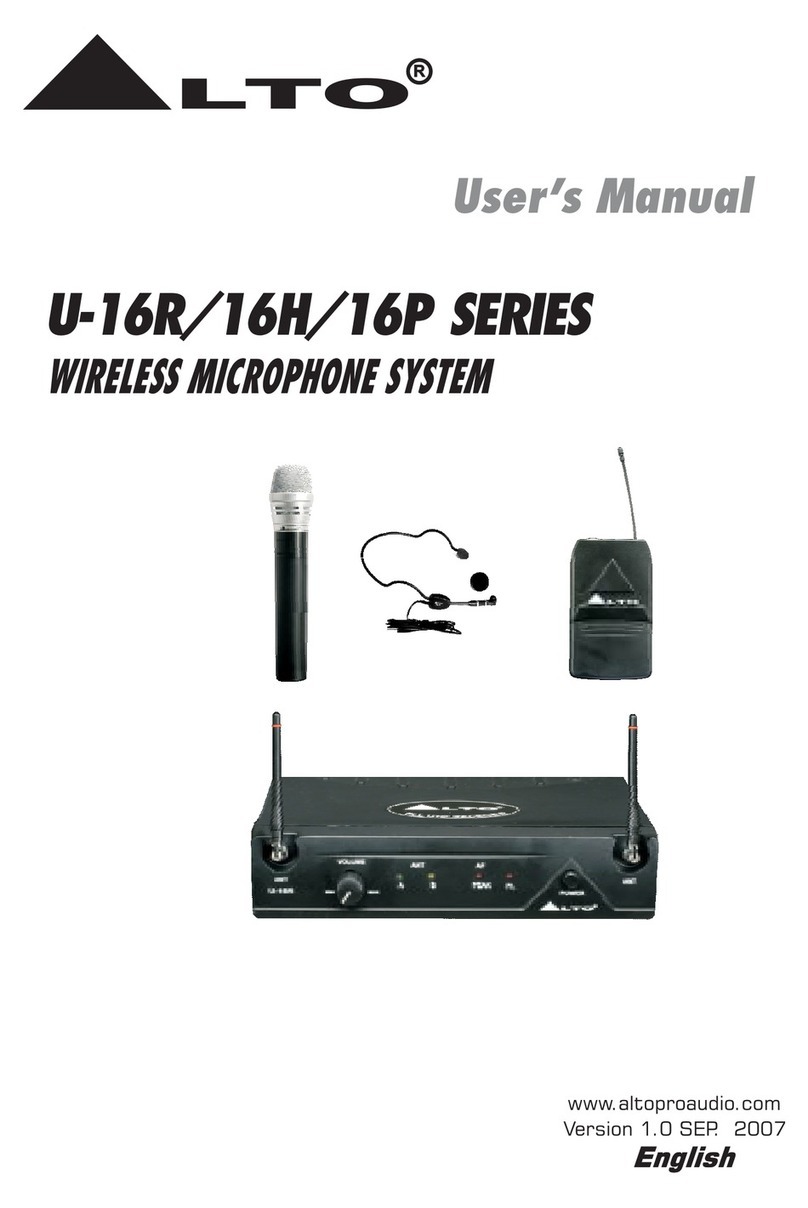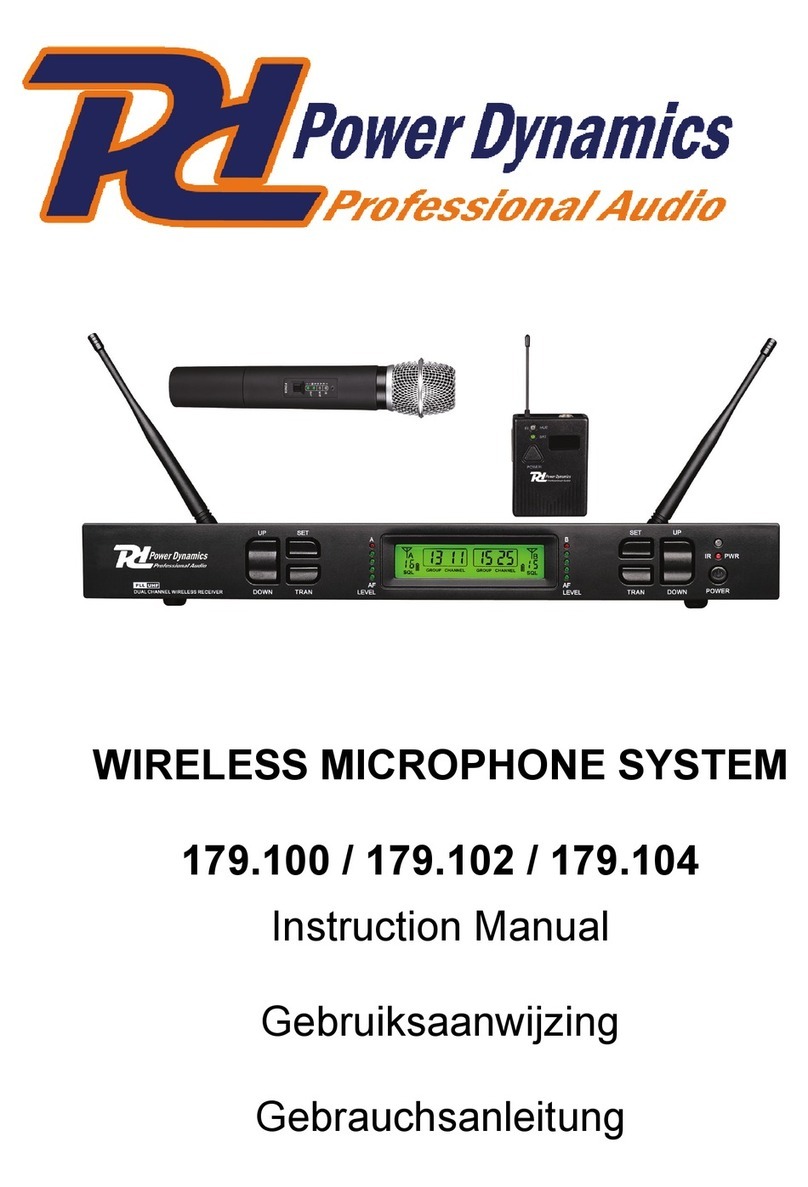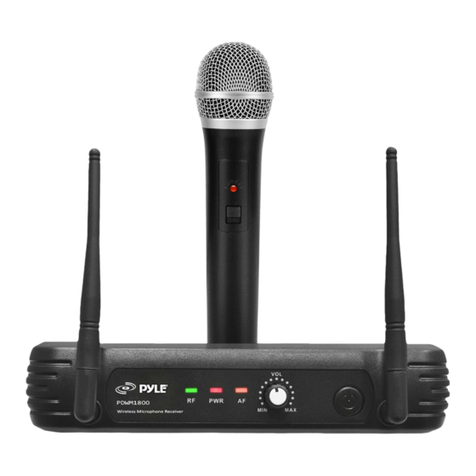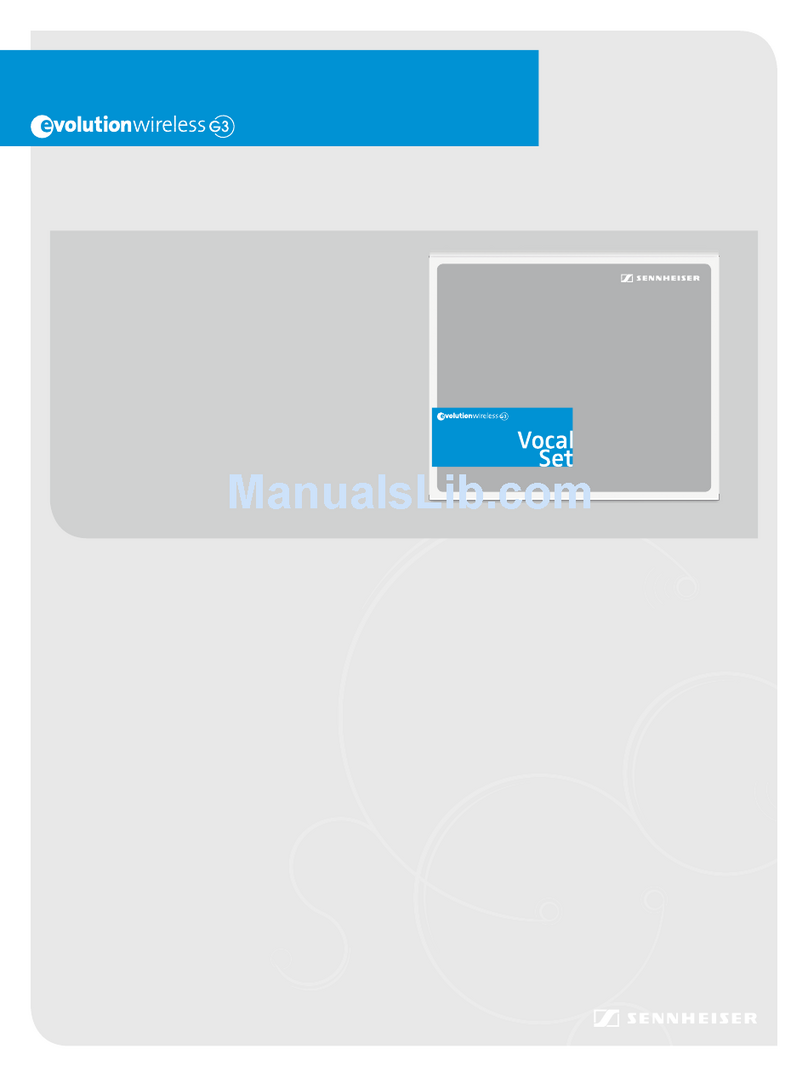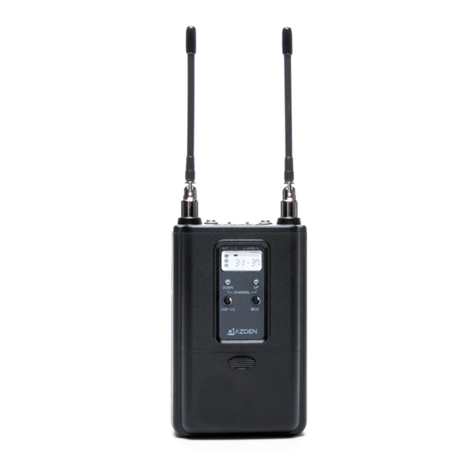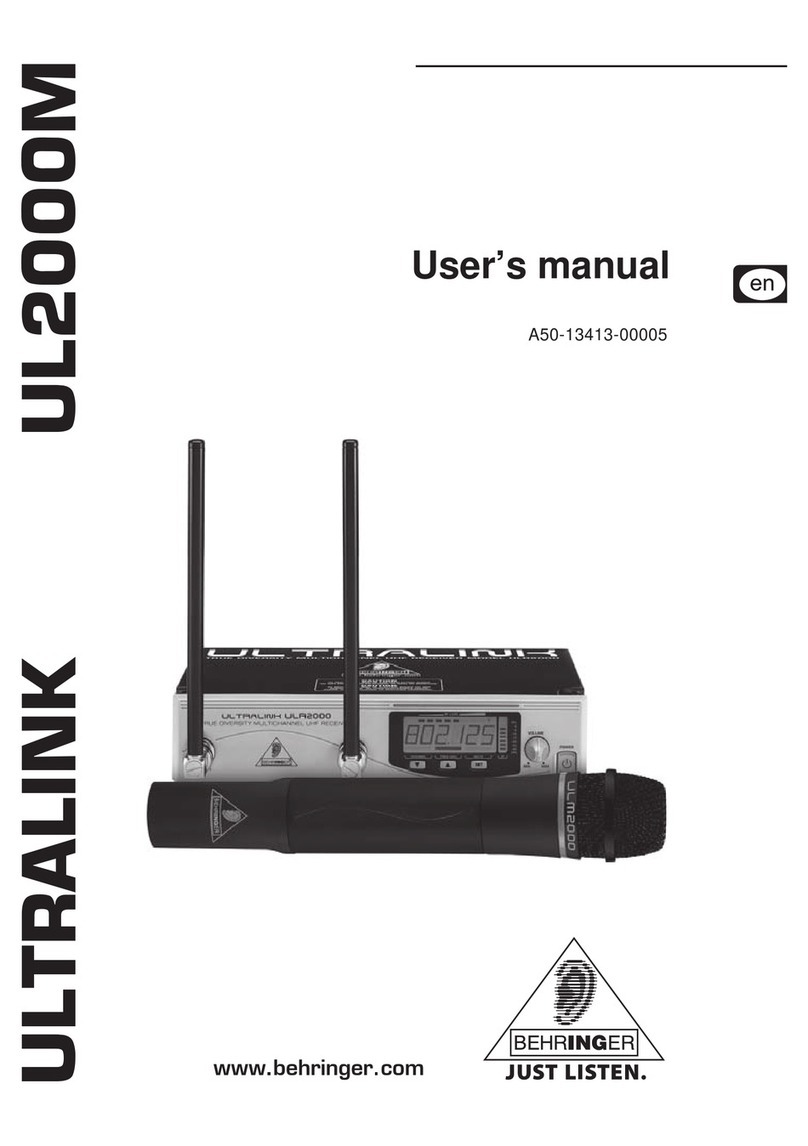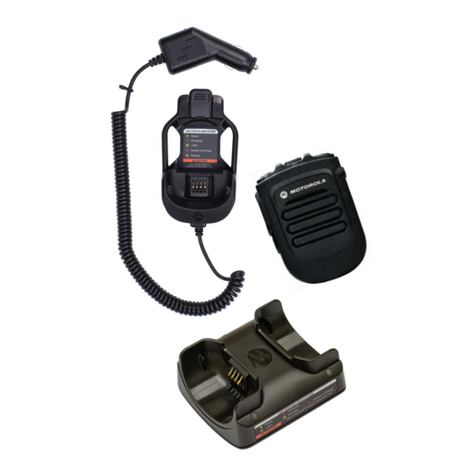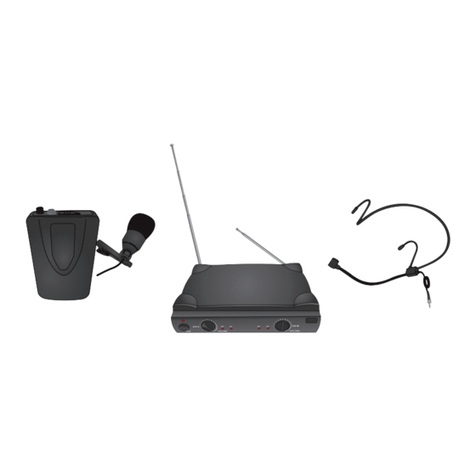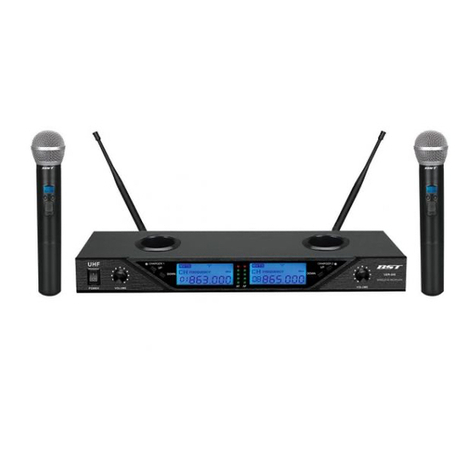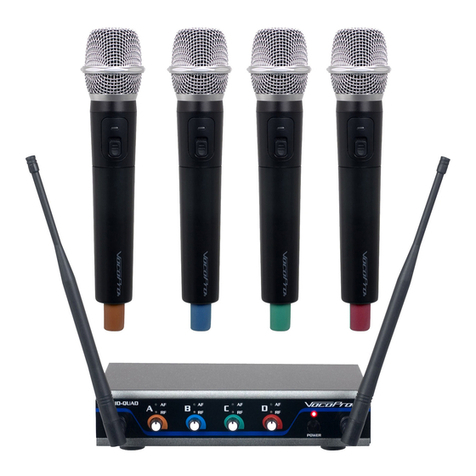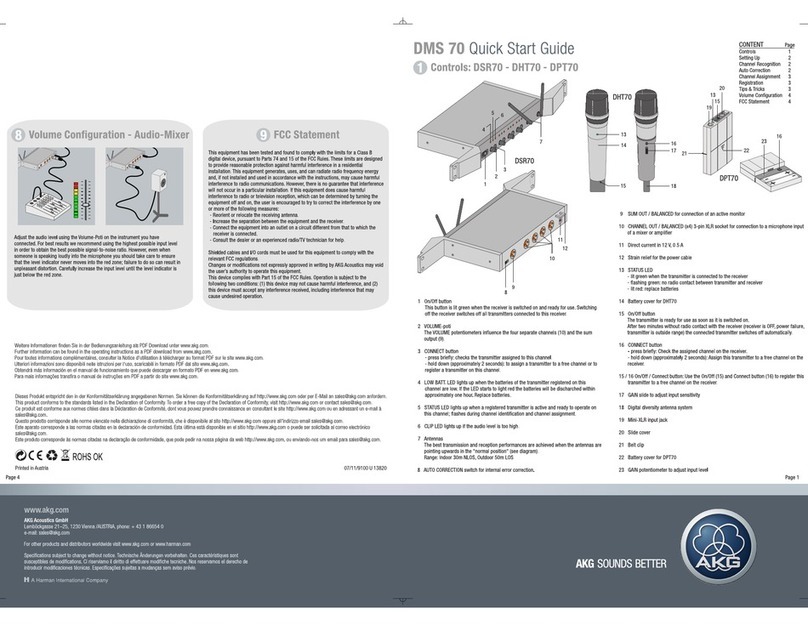Soundfield DSF-2 MKII User manual

DSF-2 MKII
Broadcast
Microphone
System
User
Guide
Version 1.0
System
comprises:
•DSF-2 MKII 1U Digital Microphone
Controller
•DSF-2 Microphone in Leather
Case
•20m SoundField Microphone
Cable
•
Shockmount
•Mains Power
Cable
•Owners
Manual

SoundField DSF-2
User Guide
Contents
Page 2
CONTENTS
Safety Information - - - - - - - - - - 3
Getting Started - - - - - - - - - - 4-5
Controls - - - - - - - - - - - 6-9
Rycote Assembly Instructions - - - - - - - - 10-12
A Practical Guide For Use on 5.1 Outside Broadcasts - - - - - 13-15
Interfacing the DSF-2 with the DSF-3 for Live Surround Broadcast - - - 16
Specification - - - - - - - - - - - 17
Warranty - - - - - - - - - - - 18
12 Pin Connector Wiring Details for SoundField Microphone Cables - - - 19

SoundField DSF-2
User Guide
Safety Information
Page 3
SAFETY
INFORM
A
TION
•This equipment must be EARTHED.
•Only suitably trained personnel should service this equipment.
•Please read and take note of all warning and informative labels.
•Before starting any servicing operation, this equipment must be isolated from the AC supply (mains) by removing the
incoming IEC mains connector.
•Fuses should only be replaced with ones of the same type and rating as that indicated.
•Operate only in a clean, dry and pollutant-free environment.
•Do not operate in an explosive atmosphere.
•Do not allow any liquid or solid objects to enter the equipment. Should this accidentally occur then immediately
switch off the unit and contact your service agent.
•Do not allow ventilation slots to be blocked.
Cleaning
For cleaning the front panels of the equipment we recommend anti-static screen cleaner sprayed onto a soft cloth to
dampen it only.
Explanation
of
Warning Symbols
The lightening flash with arrow head symbol within an equilateral triangle is
intended to alert the user to the presence of dangerous voltages and energy levels
within the product’s enclosure that may be of sufficient magnitude to constitute a
risk of electric shock or injury.
The exclamation mark within an equilateral triangle is intended to prompt the user to
refer to important operating or maintenance (servicing) instructions in the
documentation supplied with the product.

SoundField DSF-2
User Guide
Getting Started
Page 4
GETTING S
T
AR
TED
WARNING: The DSF-2 microphone is not compatible with other SoundField Control
Units
in
the product range. SoundField Ltd will not accept any responsibility for damage caused by
the interconnection of these units.
WARNING: The DSF-2 1U digital controller should be sited in a cool operational
environment in a well ventilated rack with 1U free space above the unit.
BEFORE USE
Before applying mains power to the DSF-2 system, connect the microphone to the controller with
the interconnection cable provided. When connecting the microphone, make sure the red dot on the
Lemo Female 12 Pin In-Line Connector is aligned with the red dot at the base of the microphone
before insertion. To disconnect the cable push the disc forward on the base of the microphone and
release the connector.
Push silver disc on microphone
base at the ‘red dot’ position to
release connector.
When connecting the microphone cable to the DSF-2 controller, ensure the red dot is facing
upwards. To disconnect, pull back on the silver connector grip and release.
It is essential that the microphone be powered up a few minutes before use to allow the capsule
charging process to stabilise. If the microphone has been used recently, the time taken to stabilise
may be shorter, but turning the microphone on fifteen minutes or so before it is needed is a good
habit to acquire.
In conditions where condensation is likely to be a problem, for example, when bringing the
microphone from a cold vehicle to a warm venue, it is advisable to leave the microphone switched
on for up to half an hour before use so that the internal heating system can clear the capsules of all
condensation.
The DSF-2 system does not require Phantom Power (48V) if it is connected to a mixing console.
Please ensure that the Phantom Power on the mixer input channels is turned off.

SoundField DSF-2
User Guide
Getting Started
Page 5
MICROPHONE ORIENTATION GUIDE
The illustrations below show the correct status of the End-Fire and Invert switches on the DSF-2
controller relative to the orientation of the microphone.
KEYS TO
PROPER PLACEMENT
OF SOUNDFIELD
MICROPHONES
Getting the mic in the right place is the first step in making a good recording. With SoundField
microphones, it is too easy to be lulled into complacency by the excellent stereo and surround
sound pick-up they provide. The temptation is to put it up, turn a few knobs, and go with it.
However, with a little more attention to detail this “good” sound will always become even better.
Be sure to set the appropriate Orientation mode (Side Fire or End Fire ) to tell the DSF-2
processor how the microphone is facing. Then, before ever opening the mic up to stereo, it is
important to listen to the microphone as a monophonic pick-up. Set the Pattern control to
Omni and
the Width control to 0° and listen to the overall sound. Pay particular attention to the balance
within the sound source - i.e. the balance among the performers, the relationship of direct-to-
reverberant sound, extraneous noises, etc. If it doesn’t sound right, move the microphone around
until it does. At this point adjust the Pattern control to focus more on the sound source and less on
the surrounding environment by utilising the cardioid and figure-of-eight patterns.
Remember that the essence of SoundField microphones is based on the Mid/Side technique, where
the Mid microphone provides the basic sonic balance. Therefore, once it sounds good in mono, it
always will sound great in stereo; the converse, however, is not necessarily true. Only after you are
satisfied with the mono pick-up, should you open-up the microphone into stereo. Set the Pattern
control to the polar pick-up you think will be a good starting point and adjust the Width control for
your desired stereo image. You can adjust both controls to achieve exactly the right stereo
perspective for your recording. Pay particular attention to the direct-to-reverberant sound.
Remember that too much reverb makes a recording sound “mushy” and vague. The beauty of
SoundField microphone systems is their unequalled clarity and articulation. Don’t waste this by
including too much extraneous sound - unless, of course, that is want you want to do! Also keep
an eye on the level meters to be sure that you are not likely to overload the microphone’s
electronics.

SoundField DSF-2
User Guide
Controls
Page 6
CONTROLS
INPUT PAGE - provides all parameters relating to mic-pre and the microphone
orientation.
1.
Gain
The Gain of the built-in mic-pre amplifiers is switched in 1dB steps and a total of 50dB of gain can
be added.
To change the mic-pre gain press the “Gain” button - this will change the display to show the gain in
the middle of the screen –and use the rotary controller to alter the gain.
To return back to the main screen either press the “Gain” button again or wait for the gain screen to
automatically time out.
2.
Limiter
A switchable fixed threshold soft limiter is provided to eliminate the possibility of ‘digital
overload’ and any resulting distortion. It is recommended that the limiter is engaged at all times,
particularly in wide dynamic range environments such as concert halls or sporting events where
sudden crowd applause can create high sound pressure levels.
To enable the limiter press the “Limit” button - this will change the display to show the limit
status in the middle of the screen –further presses of the “Limit” button will toggle the status of
the limiter between on and off. A red lamp will light up on the display next to the limiter label
to indicate limiter activity.
To return back to the main screen either press the “
Limiter
” button again or wait for the gain screen
to automatically time out.

SoundField DSF-2
User Guide
Controls
Page 7
3. End
Fir
e
The End Fire mode should be selected when the microphone is horizontally pointed ( ) at the
sound source as you would with a flashlight. Selecting End Fire maintains the correct three-
dimensional perspective in both surround and stereo when the mic is used in the horizontal
position.
If you do not select this mode when the microphone is horizontal it will result in the Front/Back
depth information and the Up/Down height information being reversed. This mode is particularly
necessary when the microphone is mounted in a Rycote or on a fishpole and pointed directly at the
sound source.
To enable End Fire press the “End Fire” button - this will change the display to show the End Fire
status in the middle of the screen –further presses of the “End Fire” button will toggle the status
of End Fire on and off.
To return back to the main screen either press the “End
Fir
e
” button again or wait for the gain screen
to automatically time out.
4.
Invert
The INVERT mode maintains the correct three-dimensional perspective in both surround and
stereo when the microphone is suspended upside down above the sound source ( ). Not
selecting this mode with the mic suspended will result in the Left/Right width information and
Up/Down height information being reversed. It is important to document the status of the Invert
switch when making B-Format recordings for later post production.
To enable
Invert
press the “
Invert
” button - this will change the display to show the
Invert
status
in the middle of the screen –further presses of the “
Invert
” button will toggle the status of
Invert
on and off.
To return back to the main screen either press the “
Invert
” button again or wait for the gain screen to
automatically time out.
5.
High Pass Filter
The variable High-Pass filter –second order Butterworth –will filter the incoming microphone
signals and will affect all output signals. Enabling the High-Pass filter is ideal for removing
unwanted low frequency rumble such as wind noise, etc.
To enable the
High Pass Filter
press the “
High Pass Filter
” button - this will change the display
to show the
High Pass Filter
status in the middle of the screen –further presses of the “
High
Pass Filter
” button will toggle the status of
Invert
on and off and the rotary controller will alter
the cut-off frequency.
To return back to the main screen either press the “
High Pass Filter
” button again or wait for the
gain screen to automatically time out.

SoundField DSF-2
User Guide
Controls
Page 8
STEREO
CONTROL
SCREEN - the controls in the Stereo Section have no
effect on the four B-Format output signals.
1. Width
This control varies the stereo image from zero degrees (mono) through 90 degrees (standard stereo
coincident pair) to an extra wide stereo 180 degrees. The effect of the Angle control can be viewed
on the screen.
To change the Width press the “Width” button and use the rotary controller to alter the gain.
2.
Polar Pattern
The Polar Pattern control is continuously variable ranging from Omni through Sub-Cardioid,
Cardioid, Hyper-Cardioid to Figure-of-eight and sets the polar patterns used for the stereo pair.
To change the Pattern press the “Pattern” button and use the rotary controller to alter the gain.
3. Mid/Side
The Mid/Side control switches the stereo outputs from L/R to M/S. When the Mid/Side button
is enabled the stereo outputs will be M/S encoded. The Left output channel provides the Mid
signal and the Right output channel provides the Side signal.
To enable the Mid/Side mode press the “Mid/Side”button, further presses will toggle the Mid/Side
on and off. The Mid polar pattern can be altered by using the polar patter control as described
above.

SoundField DSF-2
User Guide
Controls
Page 9
REAR
P
ANEL
1 2 3 4
5
1. MAINS POWER - IEC mains power inlet.
2. ETHERNET PORT - for future functionality
2. DIGITAL OUTPUT SECTION - the DSF-2 outputs digital stereo and B-Format
simultaneously on 75 ohm AES 3-id via BNC connectors. The digital audio signals can be sent
down up to one kilometer of coaxial cable (subject to correct cable specification) without loss of
quality.
3. WORD CLOCK INPUT AND OUTPUT –75Ohm wordclock I/O on BNC
4. STEREO OUTPUT - Left/Right stereo analogue balanced line outputs on XLR conncetors.
(Pin 1 = ground, Pin 2 = + (positive) and Pin3 = - (negative).
5. MIC INPUT - Lemo 12 pin female panel mount connector. The DSF-2 system will drive up to
250m of SoundField mic cable with no loss of quality or signal level.

SoundField DSF-2
User Guide
Rycote Assembly Instructions
Page 10
RYCOTE ASSEMBLY
INSTRUCTIONS
1 DSF-2 Microphone and Rycote kit in
flightcase.
2 Remove end of Windshield by turning in an
anti-clockwise direction.
3 Loosen the two black plastic bolts situated on
the Pistol Grip under the Windshield.
4 Remove Windshield by gently sliding away
from the Pistol Grip.

SoundField DSF-2
User Guide
Rycote Assembly Instructions
Page 11
5 Insert microphone into the inner cradle.
6
IMPORTANT:
WHEN THE MIC IS RIGGED
IN
ITS FINAL
POSITION
IN THE STADIUM
FOR
END-FIRE USE, THE SOUNDFIELD LOGO ON
THE MIC BODY MUST BE
F
ACING
DOWN
W
ARDS.
SoundField logo
facing downwards
7 When microphone is fully inserted, tighten the
two Allen bolts with the Allen key provided.
Make sure the microphone is securely mounted
in its inner cradle.
8 Partly replace Rycote Windshield over the
DSF-2 microphone.

SoundField DSF-2
User Guide
Rycote Assembly Instructions
Page 12
9 Connect microphone
cable ensuring that the
red dot on both the
microphone and cable
connector are lined up.
10 Insert the microphone cable into the groove
provided on the underside of the Windshield
before replacing end of Windshield. Ensure the
Windshield end is securely located in its
original position.
11 Insert Windshield into the Rycote Windjammer.
12 When the Windjammer completely covers the
Windshield, secure its position by tightening
the pull-strings and place excess string inside
Windjammer.

SoundField DSF-2
User Guide
A Practical Guide for use on 5.1 Outside Broadcasts
Page 13
A
PRACTICAL
GUIDE FOR USE ON 5.1 OUTSIDE
BROADCASTS
by Robert Edwards, VSS
Ltd.
Only now have the true benefits of SoundField microphones become apparent to the sound mixers
in the live television community who are now being asked to deliver 5.1 audio and more, to
accompany live High Definition Broadcasts. Many such HDTV Broadcasts are for sporting events
where there is no rehearsal and a limited amount of set-up time.
Where should the microphone go in the stadium? The microphone is simplicity itself to rig and is
very tolerant of positioning. It has been said that as long as the microphone is in the same stadium
as the event, the ambience captured will be very enjoyable! However, there are some basic rules
that should be followed...
The microphone must be placed at least five metres from any individual crowd members, and in
such a position so as not to be physically disturbed. Individual claps or voices that are too close to
the microphone will result in making the rest of the ambience difficult to control. The microphone
must be securely mounted, generally clamped to a stadium structure, protected from the elements
(direct wind and rain) with suitable wind and rumble isolation. Generally, the higher and more
centrally-placed above the main crowd or audience, the better the overall sound experience will be.
Typical Crowd
Stand
Optimum position
for
SoundField
Microphone

SoundField DSF-2
User Guide
A Practical Guide for use on 5.1 Outside Broadcasts
Page 14
The main wide-shot camera position for any event should be used as the reference position for the
SoundField, although this camera position may sometimes not be placed where the main crowd
reactions occur. If the microphone has good free space around it, then the aural image will be
impressive.
SoundField Microphone position near Main Camera
Platform
The microphone itself is housed in a Rycote-type windshield. The body of the microphone lays flat
in the mounting clips with the SoundField badge on the microphone downwards. The multi-pin
connector is mated with the microphone and sealed inside the Rycote basket. The microphone,
inside this windshield is then pointed at the main on-field action. In this position the microphone is
said to be in “End-fire” mode, and the “End-fire” switch on the Control Unit should be selected. If
the microphone is rigged so that the SoundField badge is upward, then the “Invert” switch must be
selected. The multi-pin cable is connected from the microphone to the Control Unit. This outputs
four channels of SoundField “B-Format” signals which are algebraic vectors W, X, Y and Z that
are derived from the capsules. The Control Unit is where the gain and orientation of the microphone
is adjusted. The SoundField microphone has a small heating element inside the body, which keeps
the capsules warm and dry. It is therefore essential that the microphone is powered-up well before
use when conditions are humid.
Close-up of optimum position of
SoundField Microphone in full Rycote kit SoundField Microphone before Rycote
Windshield and Windjammer are fitted

SoundField DSF-2
User Guide
A Practical Guide for use on 5.1 Outside Broadcasts
Page 15
The SoundField has a very low noise-floor and can cope with a wide dynamic range. This is good,
since the crowd reactions of sporting events also tend to have a wide dynamic range. The gain is
best set while the stadium is performing tests on the PA system for safety announcements, as these
are generally very loud and offer a guide to the high SPL achieved in the stadium.
SoundField DSF-2 Microphone in Rycote as seen from Crowd
Stand

SoundField DSF-2
User Guide
Interfacing the DSF-2 with the DSF-3 Digital Surround Processor for live Surround Broadcast
Page 16
INTERFACING
THE DSF-2 WITH THE DSF-3 DIGITAL
SURROUND
PROCESSOR
FOR LIVE SURROUND
BROADCAST
In this configuration the DSF-2/DSF-3 combination will deliver six discrete channels of digital 5.1
surround sound. It is a very quick and effective way to record surround. After some practice and
once you know how to get the best from your system, it will yield consistent results. Although not
vital, it is a big advantage to be able to monitor in full surround when choosing your mic position.
If monitoring in full surround is not possible during set-up, engaging the Rotate control at 180º
with
the Pattern control set to Cardioid and the Angle control set to 90º will provide
a representation
of
the rear sound field (Surround Left, Surround Right).
NOTE: Any use of the DSF-2’s Rotate control during a live
broadcast
or
recording
will
be
embedded in the 5.1
audio.
If post-production capability is required at a later date for the audio material it is essential to record
the four B-Format signals. A live stereo feed is provided by the DSF-2 or the DSF-3 will provide a
stereo feed in post-production.

SoundField DSF-2
User Guide
Specification
Page 17
SPECIFIC
A
TION
Audio Specification - Control
Unit
Analogue
Inputs:
maximum input level
24dBu
Analogue
Limiter:
when enabled threshold set to 22dBu Analogue
Bandwidth:
10Hz –20KHz +/- 0.1dB
Analogue to Digital
Converter:
2 x CS5381
Supported
Sample rates: 48K
Audio Specification -
Micr
ophone
Frequency
Response: 20H to20KHz, +/-3dB
Capsule Sensitivity: 13mV/Pa
Signal to Noise Ratio DIN/IEC: 81dB
Equivalent
Noise DIN/IEC: 13dB
Maximum SPL: 145dB
Word Clock I/O
Specification
Word Clock input: 75Ohm BNC, 200mVpk-pk minimum input level
Word Clock
output:
75Ohm BNC, 4.5Vpk-pk into 75Ohm load
Mains
Requir
ements
AC
Input: 95
VAC or 245VAC 50/60Hz auto ranging
Power
Consumption:
~20W
Dimensions - Control
Unit
Case Size: 482mm (w) x 44mm (h) x 259mm (d)
Dimensions -
Micr
ophone
Microphone Size –69mm (width at widest point) x 240mm (length without connector)
Weight: 500g
All specifications are subject to change without notice.

SoundField DSF-2
User Guide
Warranty
Page 18
W
ARRANTY
Limited
Liability
SoundField Ltd., herein after known as the manufacturer, guarantees this equipment from defects in material and
workmanship under normal use and service for a period of one year. This guarantee extends to the original purchaser
only and does not apply to fuses or any product or parts subjected to misuse, neglect, accident or abnormal
conditions
of
operation. The guarantee begins on the date of delivery to the actual purchaser or to his authorised agent or carrier. In
the event of failure of a product covered by this guarantee, the manufacturer or their certified representatives will repair
and calibrate equipment returned prepaid to an authorised service facility within one year of the original purchase and
provided that the guarantors examination discloses to its satisfaction that the product was defective, equipment under
this guarantee will be repaired or replaced without charge. Any fault that has been caused by misuse, neglect, accident,
act of god, war or civil insurrection; alteration or repair by unauthorised personal; operation from an incorrect power
source or abnormal conditions of operation, will not fall under this guarantee. However, an estimate of the cost of the
repair work will be submitted before work is started. The manufacturer shall not be responsible for any loss or damage,
direct or consequential, resulting from machine failure or the inability of the product to perform. The manufacturer shall
not be responsible for any damage or loss during shipment to and from the factory or its designated service facility. This
guarantee is in lieu of all other guarantees, expressed or implied, and of any other liabilities on
the manufacturers part. The manufacturer does not authorise anyone to make any guarantee or assume any liability not
strictly in accordance with the above. The manufacturer reserves the right to make changes or improvement in the
design and construction of this unit without obligation to make such changes or improvements in the purchaser's unit.
Any dispute arising from this warranty shall be subject to the laws of England.
What to do if a fault is found or you need
suppor
t
In the unlikely event that a fault develops with your product, please contact support as follows:
By email using
support@tsl.co.uk
By telephone on +44 (0)1628 676221
Claim for damage during
transit
All products should be thoroughly inspected immediately upon delivery. If there is any damage to the product a claim
should be filed with the carrier immediately. A quotation to repair shipment damage can be obtained from SoundField
Ltd. Final claims and negotiations with the carrier are the responsibility of the customer.
Repair process and how to
return
your goods
In the first instance you should contact support using the contact details above. In the event that your product needs to
be returned, a unique return number will be provided which should be used for all further correspondence.
Repairs and returned goods are subject to the following conditions:
•No equipment should be returned without the prior consent of SoundField/TSL Professional Products Ltd.
•Shipping/Insurance costs for returned items are the responsibility of the customer.
•All returned goods must be suitably packaged to avoid damage and preferably in the original purpose built
SoundField packaging. If this is not possible, packaging may be available from
SoundField.
•In the event of transit damage, you will be advised immediately and the repair of the unit may be subject to
additional costs which will be quoted before repair work commences.
•Warranty repairs will be returned free of charge (subject to the limited liability terms detailed elsewhere in this
document)
•Non - warranty repairs will be inspected and an estimated cost provided before work starts.
•If after initial inspection we find the product is beyond economic repair (BER) you will be notified and charged for
inspection only.
•Non-warranty repairs will be subject to additional return shipping costs.
Application
support
or
help
SoundField Ltd will be happy to answer any applications questions to enhance your use of this equipment. Please
contact support using the details provided above.

SoundField DSF-2
User Guide
12 Pin Connector Wiring Details for Microphone Cables
Page 19
12 PIN
CONNECTOR
WIRING DETAILS FOR
MICROPHONE CABLES
12 Pin
Male
Pin 1
- LB (+)
12 Pin
Female
- Pin 1
Pin 2
- LB (-)
- Pin 2
Pin 3
- RB (+)
- Pin 3
Pin 4
- RB (-)
- Pin 4
Pin 5
- RF (+)
- Pin 5
Pin 6
- RF (-)
- Pin 6
Pin 7
- LF (+)
- Pin 7
Pin 8
- LF (-)
- Pin 8
Pin 9
- Voltage GND
- Pin 9
Pin 10
- -V
- Pin 10
Pin 11
- +V
- Pin 11
Pin 12
- Signal GND
- Pin 12
SOUNDFIELD COLOUR CODING
Pin 1 - White
Pin 2 - Purple
Pin 3 - Grey
Pin 4 - Pink
Pin 5 - Green
Pin 6 - Yellow
Pin 7 - Red
Pin 8 - Blue
Pin 9 - Black
Pin 10 - Brown
Pin 11 - Orange
Pin 12 - Screen (plus link to connector chassis)
Important
Note: Use colour coding as above as some wires have a different number of strands.
Other manuals for DSF-2 MKII
1
Table of contents
Other Soundfield Microphone System manuals
